Crowding of the teeth
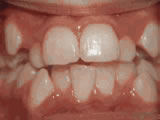 Before
Before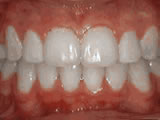 After
AfterPatient started treatment at age 11 and wore braces for 26 months. He loves his new smile.
Open bite - Front teeth don't touch
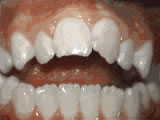 Before
Before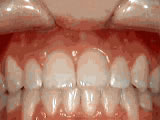 After
AfterPatient sucked her thumb as a young child. She started treatment at age 13. She had braces and a special appliance — called a crib — to retrain the tongue, for 28 months. Now she can bite the lettuce out of a sandwich.
Deep overbite - Lower front teeth bite into palate
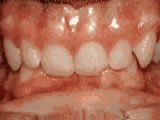 Before
Before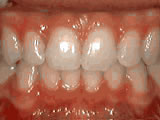 After
AfterThis adult patient, age 25, required braces and jaw surgery to correct his severe overbite, with treatment taking two years. His problem could have been corrected without surgery if he had been treated before he was a teenager.
Missing lateral incisors
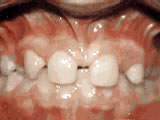 Before
Before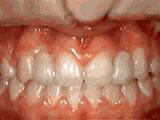 After
AfterThis patient's lateral incisors were congenitally missing. She had braces for 20 months to move the teeth into their correct positions, then the missing teeth were replaced with bonded "Maryland" bridges.
Underbite - Lower front teeth in front of upper teeth
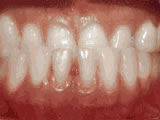 Before
Before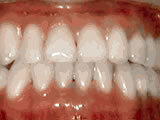 After
AfterPatient's underbite was causing her jaw joint discomfort and excessive wear patterns on her teeth. After about 30 months of treatment starting at age 32, she now finds smiling and chewing much easier.
Spacing of teeth
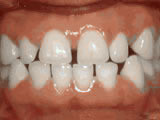 Before
Before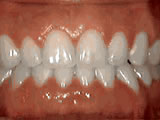 After
AfterPatient was bothered by the spaces between his teeth. Braces closed the spaces and gave him an ideal bite in 24 months. Special glued-in retainers help keep the spaces closed.
Overjet - Protruding front teeth
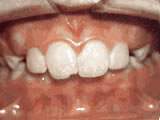 Before
Before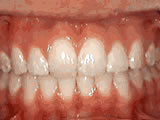 After
AfterAt age ten, patient had a big overjet with the top teeth protruding beyond the bottom. She had two phases of treatment. The first helped her jaws to grow more harmoniously and the second aligned her teeth and bite. At age 13, she was proudly displaying her new smile.
Non-braces treatment
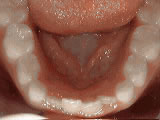 Before
Before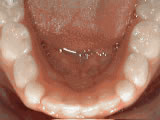 After
AfterSometimes braces are not needed to get noticeable improvements in tooth alignment. This patient was first seen at age seven for crowding of the lower permanent teeth. A procedure was performed to reduce the width of the adjacent baby teeth and the permanent incisors aligned on their own in nine months.
Phase-One
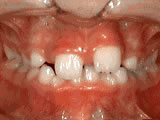 Before
Before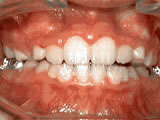 After
AfterPatient's parents were concerned about both aesthetics and the health of the erupting permanent teeth when they brought him to the orthodontist at age eight. The lower front teeth were crowded and touching the palate, and the upper front teeth were extremely displaced from their normal positions. After 12 months of Phase-One treatment with an expander and partial braces, patient's appearance and dental function were vastly improved.
Early treatment (also known as Phase One) typically begins around age eight or nine (Phase Two will begin around age 11 or older). The goal of early treatment is to correct the growth of the jaw and certain bite problems, such as underbite. Early treatment also helps to make room for permanent teeth to come in properly, lessening the chance of extractions in the future.
How to tell if your child may need early orthodontic treatment:
- Early or late loss of baby teeth (your child should typically start losing teeth around age five, and will have all permanent teeth around age 13)
- Difficulty chewing and/or biting
- Mouth breathing
- Your child continues sucking his or her thumb after age five
- Speech impediments
- Protruding teeth (the top teeth and the bottom teeth extend away from each other)
- Teeth that don't come together in a normal manner or even at all
- Shifting of the jaw when your child opens or closes his or her mouth (crossbites)
- Crowded front teeth around age seven or eight
What causes orthodontic problems, and how will early treatment benefit my child?
Orthodontic problems such as crowding of the teeth, too much space between the teeth, jaw growth problems, protruding teeth, and bad bites can be inherited or caused by injury to the mouth, early or late loss of baby teeth, or thumb-sucking habits.
Most children lose all their baby teeth by age 13, and by the end of their teen years, the jaw bones will harden and stop growing. Orthodontic procedures for adults often take more time and can involve tooth extraction or oral surgery. Receiving early orthodontic treatment as a child can help prevent the need for orthodontics as an adult, leaving little to no chance of extraction or surgery in the future.
If your child is between the ages of seven and eight and shows signs of needing orthodontic care, or if you have been directed by your family dentist to visit the orthodontist, please contact our practice and schedule an appointment. Our team will provide your child with an initial exam, and discuss with you the best steps to take toward caring for your child's smile.
Corrective Jaw Surgery
Corrective jaw surgery moves your teeth and jaws into positions that are more balanced, functional, and healthy. Whether your needs include improving your bite and function, appearance, or speech, corrective jaw surgery can have a dramatic and positive effect on your outlook on life. We are here to work together with you to help you achieve a beautiful, functional, pain-free smile that will last for the rest of your life.
Who needs corrective jaw surgery?
In some cases, your upper and lower jaws may have grown at different rates. Injuries and birth defects may also affect jaw alignment. While orthodontics can usually correct problems when only the teeth are misaligned, corrective jaw surgery may be necessary to correct misalignment of the jaws. If you suffer from any of the following conditions, you may be an excellent candidate for corrective jaw surgery:
- Difficulty chewing, biting food, or swallowing
- Chronic jaw or jaw joint (TMJ) pain and headache
- Excessive wear of the teeth
- Open bite (space between the upper and lower teeth when the mouth is closed)
- Unbalanced facial appearance from the front or side
- Facial injury or birth defects
- Receding chin
- Protruding jaw
- Inability to make the lips meet without straining
- Chronic mouth breathing and dry mouth
- Sleep apnea (breathing problems when sleeping, including snoring)
Receiving treatment to correct any of the above conditions is a commitment, not only to your health, but to your happiness as well. While treatment, which may include surgery and orthodontic treatment, may take several years to complete, the results will last a lifetime. There is no reason to live with painful, uncomfortable jaw conditions. Contact our office to learn about the best treatment option for you, your needs, and your smile.
